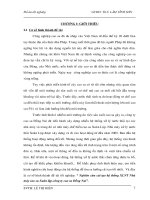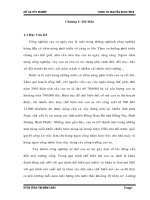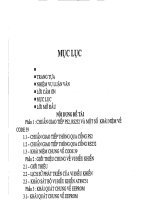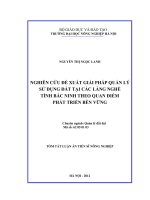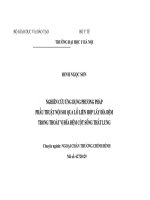Luận án tiến sĩ nghiên cứu công nghệ thích hợp xử lý nước thải quá trình chế biến cao su thiên nhiên
Bạn đang xem bản rút gọn của tài liệu. Xem và tải ngay bản đầy đủ của tài liệu tại đây (3.73 MB, 113 trang )
MINISTRY OF EDUCATION AND TRAINING
HANOI UNIVERSITY OF SCIENCE AND TECHNOLOGY
Takahiro Watari
DEVELOPMENT OF AN APPROPRIATE TREATMENT SYSTEM FOR
NATURAL RUBBER INDUSTRIAL
WASTEWATER TREATMENT
CHEMICAL ENGINEERING DISSERTATION
Hanoi – 2019
MINISTRY OF EDUCATION AND TRAINING
HANOI UNIVERSITY OF SCIENCE AND TECHNOLOGY
Takahiro Watari
DEVELOPMENT OF AN APPROPRIATE TREATMENT SYSTEM FOR
NATURAL RUBBER INDUSTRIAL
WASTEWATER TREATMENT
Major: CHEMICAL ENGINEERING
Code No.: 9520301
CHEMICAL ENGINEERING DISSERTATION
SUPERVISORS:
1. Assoc. Prof. Nguyen Minh Tan
2. Prof. Takashi Yamaguchi
Hanoi - 2019
ACKNOWLEDGMENT
Firstly I would like to thank the teachers in the PhD program, the officers in the
Department of Education, Hanoi University of Science and Technology. Thank you for all
the guidance and support you have made for me while I have fulfilled the dissertation.
Working with colleagues in the Department of Chemical Engineering has been a
privilage. I would like to thank you from the bottom of my heart for your constant
encouragement.
Finally I am so glad to have a supervisor like Assoc. Prof. Nguyen Minh Tan. Ever
since I have started to work under your supervision, I have learned a lot which really helps
me to become a better person. Thank you! You are the best supervisor ever.
I hope to receive some words of encourgement and full support from the readers in
order to make my PhD disertation better.
Hanoi, 2.12.2019
Author of the dissertation
Takahiro Watari
DECLARATION
I hereby certify that the dissertation "Development of an appropriate treatment for
industrial rubber industrial wastewater treatment" is my own research project. The data
and results stated in the doctoral dissertation are honest.
I hereby declare that the information cited in the doctoral dissertation has been fully
originated./.
Hanoi, 2.12.2019
ON BEHALF OF SUPERVISORS
Author
Assoc. Prof. Nguyen Minh Tan
Takahiro Watari
TABLE OF CONTENTS
Introduction
Objective
Task
Current Problems and its solution
1. State of the art
1.1 Natural rubber
1.1.1 Natural rubber processing process
1.1.2 Natural rubber processing wastewater
1.2 Current treatment technology for natural rubber processing
wastewater
1.2.1 Biological aerobic and anaerobic pond
1.2.2 Upflow anaerobic sludge blanket
1.2.3 Anaerobic baffled reactor
1.2.4 Activated sludge process
1.2.5 Swim bed tank
1.2.6 Down flow hanging sponge reactor
1.2.7 Dissolved air floatation
1.2.8 Membrane bioreactor
1.2.9 Combination of treatment system for natural rubber
processing wastewater
1.3 Industrial wastewater treatment process
1.3.1 Characteristics of anaerobic wastewater treatment and the
degradation pathway of anaerobic digestion
1.3.2 Anaerobic industrial wastewater treatment technology
1.3.3 Characteristics of aerobic wastewater treatment and the
degradation
1.4 Greenhouse gas emission from wastewater treatment system
2 Material and methods
2.1 Filed survey
2.1.1 Greenhouse gases collection and analysis
2.2 Laboratory UASB-DHS system
2.2.1 Raw wastewater
2.2.2 System description and operational conditions
2.3 Laboratory scale ABR system
2.3.1 Raw natural rubber processing wastewater
2.3.2 System description and operational conditions
2.4 Pilot UASB-DHS system
2.5 Analysis
2.5.1 Potential of hydrogen
2.5.2 Dissolved oxygen
2.5.3 Chemical oxygen demand
Page
1
2
2
3
4
4
7
9
13
14
15
18
21
22
22
24
25
26
27
27
30
31
32
33
33
34
36
36
38
40
40
40
42
44
44
44
44
2.5.4 Biochemical oxygen demand
2.5.5 Suspended solid
2.5.6 Total nitrogen
2.5.7 Ammonia, nitrite and nitrate
2.5.8 Volatile fatty acid (VFA)
2.5.9 Biogas production and composition
45
45
46
46
47
48
3 Results and Discussions
3.1 Characterization of current wastewater treatment system
3.1.1 Characterization of greenhouse gas emission process from
current anaerobic tank
3.2 Development concept of a laboratory scale UASB-DHS system for
natural rubber processing wastewater treatment
3.2.1 Process performance of laboratory scale UASB-DHS system
3.3 Development concept of a laboratory scale ABR experiment
3.3.1 Process performance of ABR
3.3.2 Determinates profiles inside the ABR
3.4 Development concept of a pilot scale UASB-DHS system
experiment for treatment of natural rubber processing wastewater
3.4.1 Process performance
3.4.2 Nitrogen removal and greenhouse gas emissions
3.4.3 Performance comparison of ABR-UASB-DHS system and
existing treatment system
3.5 Design guideline for full scale UASB-DHS system for natural
rubber processing wastewater in Vietnam
3.5.1 Reactor design for natural rubber processing wastewater
3.5.1.1 Pre-treatment process for UASB reactor
3.5.1.2 UASB reactor
3.5.1.3 DHS reactor
3.5.2 Calculation of Energy consumption and generation for
operation of UASB-DHS system
3.5.2.1Energy consumption of UASB-DHS system
3.5.2.2Energy production of UASB-DHS system
49
49
53
4 Conclusions
Recommendation for future study
91
93
References
95
58
58
65
65
68
70
70
76
80
84
85
85
87
88
89
89
90
Figure list
Figure 1.1
Top natural rubber produced countries over the world on
2014
Natural rubber harvested area and production in Vietnam
Natural rubber production area in Vietnam
Natural rubber manufacturing process
Schematic diagram of coagulation process
Full scale biological pond in Vietnam
Schematic diagram of UASB reactor
Various reactor configuration of ABR
Basic water flow in conventional activated sludge
Principle of downflow hanging sponge reactor and full-scale
DHS in India
Development history from DHS G1 to DHS G6
Anaerobic digestion scheme of organic compounds.
Aerobic biological degradation pathway
5
Schematic diagram of open-type anaerobic system.
Gas sampling system used in this study.
(A) Location of Thanh Hoa province, Vietnam, (B) Thanh
Hoa Rubber Factory, (C) Coagulation process in natural
rubber sheet producing process.
Schematic diagram of the baffled reactor (BR), upflow
anaerobic sludge blanket (UASB), and downflow hanging
sponge (DHS) combined system. (1) Substrate reservoir, (2)
pump, (3) pretreatment tank, (4) pump, (5–9) sampling
ports, (10) UASB column, (11) Gas solid separator, (12)
mixer, (13) heated water column, (14) water bath,
(15) desulfurizer, (16) gas meter, (17) distributor.
Protocol for preparation of natural rubber processing
wastewater following actual factory methods.
Schematic diagram of anaerobic baffled reactor.
Schematic and photo of the pilot scale ABR-UASB-STDHS system.
33
35
36
Present treatment system of a local natural rubber
processing factory.
Biogas composition of compartment 28, 33 and 56.
Methane gas emission rate and COD concentration of each
compartment.
49
Figure 3.4
Figure 3.5
COD mass balance in the OAS
Nitrous oxide rate and ammonia concentration in each
compartment.
55
56
Figure 3.6
Composition of emitted GHGs from near the influent part,
56
Figure 1.2
Figure 1.3
Figure 1.4
Figure 1.5
Figure 1.6
Figure 1.7
Figure 1.8
Figure 1.9
Figure 1.10
Figure 1.11
Figure 1.12
Figure 1.13
Figure 2.1
Figure 2.2
Figure 2.3
Figure 2.4
Figure 2.5
Figure 2.6
Figure 2.7
Figure 3.1
Figure 3.2
Figure 3.3
6
6
8
9
14
17
20
21
23
24
28
31
39
40
41
43
54
55
Figure 3.7
Figure 3.8
Figure 3.9
Figure 3.10
Figure 3.11
Figure 3.12
Figure 3.13
Figure 3.14
the center part, and the effluent part of the OAS.
Time course of pH and temperature during the operation
periods.
Time course of (a) total COD, (b) soluble COD, (c) TSS, (d)
VSS and (e) TN during the operation periods.
COD mass balance of the influent, BR effluent, and UASB
effluent.
Time course of (A) Total COD and (B) TSS concentrations
through phase 1 to phase 3
Soluble COD, acetate and propionate concentrations in
ABR on (A) 103 day and (B) 199 day
Accumulation of rubber particular in feed pipe and photo of
wastewaters
Time course of (A) Total COD removal efficiency and
organic loading rate of UASB reactor, (B) Total BOD
removal efficiency.
(A) Total nitrogen and (B) ammonia removal efficiency of
total system and DHS reactor during phase 1 to phase 4.
60
62
64
67
69
73
75
79
Table list
Table 1.1
Table 1.2
Table 1.3
Table 1.4
Table 1.5
Table 1.6
Table 1.7
Table 1.8
Table 2.1
Table 2.2
Table 2.3
Table 2.4
Table 3.1
Table 3.2
Table 3.3
Table 3.4
Table 3.5
Table 3.6
Table 3.7
Characteristics of natural rubber processing wastewater in
Vietnam.
National technical regulation on the effluent of natural
rubber processing industry in Vietnam.
(QCVN 01-MT: 2015/BTNMT)
Type of treatment process applied in Vietnam.
Application of UASB reactor for natural rubber processing
wastewater treatment.
Comparison of technologies used for natural rubber
processing wastewater treatment.
Benefits of anaerobic treatment process.
Application of anaerobic technology to industrial
wastewater
Global warming potential of greenhouse gases.
Water quality of natural rubber processing wastewater
obtained from a natural rubber sheet producing factory in
Thanh Hoa Province.
Summary of the initial operational conditions for the two
operating phases.
Operational conditions for anaerobic baffled reactor.
Initial operational conditions through phases 1 to 4.
Water quality in each sampling point at a local natural
rubber processing wastewater in Vietnam
Summary of process performance of the treatment system.
Summary of the process parameters of the system during
entire experimental period.
Biogas production and compositions of the UASB reactor.
Nitrogen concentrations (mg-N·L-1) in the proposed
system.
Characteristics of natural rubber processing wastewater in
Thailand, Malaysia and Vietnam
Process performance of the existing treatment system for
treating natural rubber processing wastewater.
11
12
13
17
26
27
30
32
37
38
40
43
51
63
74
75
78
81
83
Abbreviation words list
ABR
AnMBR
BOD
BR
CL
COD
DAF
DHS
DO
GHG
GRABAA
GSS
GWP
HRT
MBR
OAS
OLR
ORP
PVC
RSS
SRB
ST
SVR
TN
TSR
TSS
UASB
VFA
VSS
pH
anaerobic baffled reactor
anaerobic membrane bioreactor
biochemical oxygen demand
baffled reactor
concentrated latex
chemical oxygen demand
dissolved air flotation
downflow hanging sponge
dissolved oxygen
greenhouse gas
granular-bed anaerobic baffled reactor
gas-liquid-solids separation
global warming potential
hydraulic retention time
membrane bioreactor
open-type anaerobic system
organic loading rate
oxidation reduction potential
polyvinyl chloride
ribbed smoked sheet
sulfate-reducing bacteria
settling tank
standard Vietnamese Rubber
total nitrogen
technically specified rubber
total suspended solids
upflow anaerobic sludge blanket
volatile fatty acid
volatile suspended solids
potential of hydrogen
Introduction
Natural rubber is one of the most valuable agricultural products in Southeast
Asian countries. Vietnam is the 3rd largest natural rubber-producing country, and
natural rubber production in Vietnam is increasing each year. However, the natural
rubber industry discharges large amounts of wastewater containing high
concentrations of organic compounds, nitrogen, and other contaminants from several
manufacturing processes such as coagulation, centrifugation, lamination, washing,
and drying. The natural rubber processing factories in Southeast Asian countries
commonly use a combined anaerobic-aerobic lagoon system for treating natural
rubber processing wastewater because of the low installation costs. The existing
treatment systems have been demonstrated to achieve a high chemical oxygen
demand (COD) removal efficiency of 65 to 90% with easy operational methods.
However, they require a large area for the lagoon, high operating costs (especially for
surface aeration), and long hydraulic retention times (HRTs). However, the effluent
water quality of these existing treatment systems needs to be improved in order to
conform to the established discharge standards.
An upflow anaerobic sludge blanket (UASB) reactor is one of the most
promising systems for the treatment of different types of industrial wastewater
because of its high organic loading rate (OLR), low operational costs, and energy
recovery in the form of methane. Previous studies have reported the application of
the UASB reactor for the treatment of natural rubber processing wastewater. However,
it was determined that natural rubber particles remaining in the wastewater had a
negative effect on the anaerobic biological process. Therefore, the development of a
pre-treatment system to remove the remaining natural rubber particles is essential.
Moreover, when a UASB reactor is used to treat high-strength industrial wastewater,
the effluent still contains high concentrations of organic compounds and nutrients.
Thus, an aerobic treatment system is typically applied as a post-treatment to remove
residual organic matter and meet effluent standards. A downflow hanging sponge
(DHS) reactor is one of the most effective aerobic treatment systems applied as a
1
post-treatment with the UASB reactor to treat different types of industrial
wastewaters.
Objective
Current wastewater treatment systems used to treat natural rubber
processing wastewater in Vietnam consume a large amount of electrical energy and
have a large negative impact on the environment. In this study, we characterized the
process performance (e.g., water quality and biogas emission) of the current
wastewater treatment system and developed an energy-recovery type advanced
wastewater treatment system to reduce greenhouse gases (GHGes) emission and
improve the effluent quality resulting from the treatment of natural rubber
processing wastewater.
Tasks (Scientific and practical meanings)
1) Characterization of the current wastewater treatment system used to treat natural
rubber processing wastewater in Vietnam
To investigate the current situation of natural rubber processing wastewater
treatment in Vietnam, field and journal paper surveys were conducted. Moreover,
greenhouse gas emissions from an existing anaerobic lagoon were measured to
determine the environmental impact on global warming. This research will make
clear problems in current situation of natural rubber processing wastewater
treatment in an actual site. Moreover, GHGes emission from current wastewater
treatment system firstly investigated.
2) Development of an energy-recovery type wastewater treatment system
The UASB-DHS system has been applied to treat domestic sewage and
several types of wastewater. In addition, the UASB-DHS system was successfully
applied in Thailand to treat natural rubber processing wastewater, which contained a
high concentration of sulfuric acid. In this study, we examined the application of the
UASB-DHS system for treating natural rubber processing wastewater in Vietnam and
2
evaluated its process performance at the laboratory scale and in a pilot-scale
experiment. This result expected that establishment of next generation wastewater
treatment process that can achieve not only wastewater treatment but also energy
recovery.
3) Establishment of an optimal treatment system for natural rubber processing
wastewater treatment in Vietnam
Following these results, we established an optimal treatment system for
natural rubber processing wastewater treatment in Vietnam.
Current Problem and its solution
· The discharge amount of industrial wastewater in Vietnam is expected to increase
each year.
· A conventional activated sludge process is usually applied to treat industrial
wastewater in developed countries, but the installation, operation, and maintenance
of this type of system is very expensive.
· The UASB-DHS system we developed is known to be an energy-recovery and
energy-saving wastewater treatment system and has been applied to several types of
wastewater.
· If the application of the UASB-DHS system to natural rubber processing
wastewater in Vietnam is successful, it could reduce the operational costs and
greenhouse gas emissions and improve the effluent quality. Moreover, this advanced
wastewater treatment technology can be applied to not only natural rubber processing
waste water, but also other industrial wastewaters emitted in Vietnam.
3
1. State of the art
1.1. Natural rubber
Rubber is widely used in industry and can be categorized as natural rubber
and synthetic rubber. Natural rubber consists of polymers of the organic compound
isoprene, with minor impurities consisting of other organic compounds and water.
Natural rubber has good wear resistance and high elasticity, resilience, and tensile
strength. It has a good dynamic performance and a low level of damping. Therefore,
natural rubber has been widely used for carpet underlay, adhesives, foam, balloons,
and medical accessories such as rubber gloves [1]. On the other hand, synthetic rubber
is produced from coal oil. Synthetic rubbers are more resistant to oil, certain
chemicals, and oxygen and have better aging and weathering characteristics and good
resilience over a wider temperature range. Both natural rubber and synthetic rubber
can be used properly according to the application, but they are combined like an
automobile tire. The total amount of rubber consumed in 2017 reached 28,287,000
tons, and this was a 3% increase compared with the amount consumed in 2016 over
the world (IRSG report). In 2017, the amount of natural rubber produced increased
to 13,380,000 tons. Thailand and Indonesia produce over 60% of the total amount of
natural rubber (Figure 1.1).
Vietnam is the 3rd largest natural rubber producer in the world and
produced 1,094,500 tons in 2017 [2]. The quality of the natural rubber produced and
the harvested area in Vietnam have increased each year (Figure 1.2). The rubber tree
is grown mostly in the Binh Phuoc, Binh Duong, Tay Ninh, and Dong Nai provinces
in the Southeast region in Vietnam because of their favorable climate and suitable
land for the optimal growth of rubber trees (Figure 1.3). The optimal growth
conditions for rubber trees are as follows:
· Rainfall of around 250 cm that is evenly distributed without any marked dry season
and with at least 100 rainy days per year
· Temperature range of about 20 to 34°C, with a monthly mean of 25 to 28°C
4
· Atmospheric humidity of around 80%
· About 2,000 hours of sunshine per year at a rate of 6 hours per day throughout the
year
· Absence of strong winds
Top 10 of Natural Rubber Processing Countries (2014)
2%
6%
Thailand
2%
4% 3%
Indonesia
Viet Nam
34%
5%
India
China, mainland
6%
Malaysia
Philippines
7%
Guatemala
Côte d'Ivoire
7%
Myanmar
24%
Others
Figure 1.1 Top natural rubber produced countries over the world on 2014 [3].
5
Figure 1.2 Natural rubber harvested area and production in Vietnam [2]
800,000
Production (tons)
700,000
600,000
500,000
400,000
300,000
200,000
100,000
0
Southern
Highlands
Central region
region
Figure 1.3 Natural rubber production area in Vietnam [2].
6
Northern
region
1.1.1 Natural rubber processing process
Natural rubber is harvested mainly in form of the latex from the rubber
tree (Hevea brasiliensis) or other trees. Figure 1.4 show the production process for
rubber products in a natural rubber processing factory [4][5]. The latex is a sticky,
milky colloid that is obtained by making an incision in the bark and collecting the
fluid in vessels in a process called “tapping.” Raw natural rubber latex is collected
from a rubber tree, and ammonia is immediately added to keep it at a high pH to
prevent coagulation. Anti-coagulation measures are especially necessary under wet
weather conditions and with lattices that have a strong tendency for pre-coagulation.
Therefore, the amount of anti-coagulant used during the wet season is higher than
that used in the dry season. Nguyen (1999) noted that the amount of ammonia that
should be added to latex to prevent natural coagulation depends on the season [6].
· Wet season: 1.0 – 2.0 kg·tons dry rubber-1 (0.1 – 0.2% wet weight)
· Dry season: 0.5-1.5 kg·tons dry rubber-1 (0.05 – 0.15% wet weight)
The amount of ammonia also depends on the distance from the
collection site to the processing factory.
After it is transferred to the factory, natural rubber latex is first filtered
through a mesh screen to removed collated rubber, particles, leaves, and other
material. Then it is diluted with tap water. Acids such as acetate or formic acid are
added to coagulate it into a natural rubber block (Figure 1.5). The coagulated
natural rubber is pressed to make a rubber sheet and smoked in a furnace. Finally, the
rubber sheet is washed with tap water and dried in the sun. The products of natural
rubber latex are manufactured in a local factory into three types of raw rubber
sheets: technically specified rubber (TSR), concentrated latex (CL), and ribbed
smoked sheet (RSS). TSR is graded in a quality inspection after it is formed. TSR is
also called “blocked rubber” or “crumb rubber” because of its
7
morphology. TSR is the most widely used type in the US and European countries.
RSS is a smoked rubber sheet and largely used in industry
Figure 1.4 Natural rubber manufacturing process [5].
8
Figure 1.5 Schematic diagram of coagulation process [5]
1.1.2 Natural rubber processing wastewater
The main products from local natural rubber processing factories are CL and
RSS. The production processes for these products such as coagulation, centrifugation,
lamination, washing, and drying use a large amount of fresh water and discharge the
same amount of wastewater. In Vietnam, surface water and ground water are mostly
used. Previous study reported that in Vietnam 25 m3 wastewater is discharged from
the production of 1 ton of RSS from fresh latex, whereas approximately 18 m3
wastewater is discharged to produce 1 ton of CL [7]. This wastewater heavily polluted,
and it is causes environmental problems because of insufficient wastewater treatment
[8]. The characteristics of natural rubber processing wastewater are very different
between the RSS and latex production processes. Table 1.1 summarizes the effluent
quality of natural rubber processing wastewater in Vietnam. Nguyen (2003) surveyed
27 rubber processing factories in five provinces and summarized the quality of their
effluents [4]. These wastewaters mainly contained wash water and small amounts of
uncoagulated latex and serum with small quantities of proteins, carbohydrates, lipids,
carotenoids, and salts. The wastewater discharged from the CL producing process is
the most polluted wastewater compared to other wastewaters because this wastewater
contains high concentrations of uncoagulated rubber particles and organic matter [7].
The COD and total suspended solids (TSS) in latex wastewater are approximately
9
20,000 mg·L-1 and 500 mg·L-1, respectively. The wastewater discharged from
factories producing standard Vietnamese Rubber (SVR) rubber sheets is acidic (e.g.,
pH 4.8~5.5). The main organic compounds in this natural rubber processing
wastewater are volatile fatty acids (VFAs). Acetate and formic acid have been widely
used for field latex coagulation in Vietnam. Specifically, the natural rubber processing
wastewater collected from the coagulation process at a rubber processing factory in
Thanh Hoa province, Vietnam, was reported to contain 4,000 mg-COD·L-1 acetate
and 4,500 mg-COD·L-1 propionate [9].
Both CL wastewater and SVR wastewater contain a high concentration of
ammonia (e.g., 100 mg-N·L-1 to 1,000 mg-N·L-1). Ammonia is added to the latex in
the tapping cups and collecting buckets to increase the pH of the latex to prevent
premature coagulation. The amount of ammonia added to latex to prevent natural
coagulation depends on the season and the distance from the collection site to the
processing factory [10]. The wastewater from CL factories contains a high
concentration of nitrogen.
The industrial effluent discharge standards for environmental protection are
usually provided by the government. Natural rubber processing wastewater is one of
the largest sources of industrial wastewater pollution in Southeast Asian countries,
and usually, specific and strict effluent standards are established for natural rubber
processing factories. In Vietnam, the Ministry of Natural Resources and the
Environment provides national technical regulations for the effluent of the natural
rubber processing industry (QCVN 01-MT: 2015/BTNMT). The Vietnamese effluent
standards for water quality are shown in Table 1.2. Standard A is applied for effluent
discharged into the domestic water supply (used for daily activities, except directly
for drinking and cooking). Standard B is applied for other water supplies other than
the domestic water supply). The national technical regulations published 2015
contain two categories: new factories (started operation after 31/March/2015) and
existing factories (started operation before 31/March/2015).
10
Table 1.1 Characteristics of natural rubber processing wastewater in Vietnam.
11
Table 1.2 National technical regulation on the effluent of natural rubber processing
industry in Vietnam.
(QCVN 01-MT: 2015/BTNMT)
12
1.2.
Current treatment technology for natural rubber processing
wastewater
As mentioned above, natural rubber processing wastewater contains large
amounts of organic compounds and nitrogen. In addition, unbiodegradable natural
rubber particulates remain in the wastewater, and thus, the wastewater treatment
system needs to remove these rubber particulates. Currently, several types of
wastewater treatment systems have been applied for natural rubber processing
wastewater treatment (Table 1.3). In natural rubber producing countries such as
Southeast Asian countries, low-cost wastewater treatment systems for treating this
type of wastewater are desirable. The effluent treatment processes in use in Vietnam
were surveyed by Nguyen (2003) [4]. Aerated lagoons and ponds are commonly used
for the treatment of this wastewater. On the other hand, the application of advanced
treatment processes such as dissolved air flotation (DAF) and an UASB reactor has
been limited. Therefore, simple, natural processes such as the biological pond method
have been widely applied.
Table 1.3 Type of treatment process applied in Vietnam [4].
Type of treatment process
No. of applying factory
Aerated lagoon
11
Pond
10
Dissolved air flotation
6
Upflow anaerobic sludge blanket
3
Cheminal precipitation
2
Sequence batch reactor
1
Septic tank
1
Conventional activated sludge
1
Trickling filter
1
13
1.2.1 Biological aerobic and anaerobic pond
The biological pond (lagoon system) is commonly used for the treatment of
natural rubber processing wastewater in Southeast Asian countries (Figure 1.6). More
than 500 anaerobic biological ponds have been installed in Malaysia for palm oil and
natural rubber processing factories [11][12][8][13]. With this system, it is possible to
achieve a high organic removal efficiency with low operational and installation costs.
The oxidation ditch process (aerated lagoon) is the most popular treatment system for
natural rubber processing wastewater in Vietnam [4]. In this system, usually, 2, 4, or
6 units are arranged in series, parallel, or both and equipped with surface floating type
aerators. Ibrahim (1980) demonstrated the possibility of achieving efficient ammonia
nitrogen removal in a laboratory-scale experiment [14]. Currently, this process is
combined with a rubber trap and/or anaerobic lagoon, and the final effluent water
meets the effluent standard or water quality stated in in Vietnamese Standard B [7]
[15]. However, a local factory consumes a large amount of electricity for
wastewater treatment, higher even than the amount used for natural rubber production
[15]. In addition, GHG emissions from the oxidation ditch process are of concern
because of the low dissolved oxygen (DO) concentration and low C/N ratio in
natural rubber processing wastewater.
Figure 1.6 Full scale biological pond in Vietnam.
14
1.2.2 Upflow anaerobic sludge blanket reactor
A UASB reactor is one of the most promising systems for the treatment of
different types of industrial wastewater because of its high OLR capacity, low
operational costs, and energy recovery in the form of methane [16]. The formation of
well settleable sludge aggregates and the application of a reverse funnel-shaped
internal gas-liquid-solids separation (GSS) devise are key technologies for a
successful UASB reactor (Figure 1.7). The characteristics of the UASB are listed
below.
1)
The influent is fed from a bottom reactor in order to create upflow.
2)
If the UASB reactor is correctly operated, granulation can occur and result
in the formation of high settleability sludge in the reactor.
3)
The UASB reactor has a high contacting efficiency because of high biogas
production
4)
The washed-out sludge is effectively collected by the GSS.
5)
There is 90% less excess sludge from the UASB reactor compared with that
from an activated sludge process.
Table 1.4 summarizes the process performance of the UASB reactor when
treating natural rubber processing wastewater. The first application of a UASB
reactor for the treatment of natural rubber processing wastewater in Vietnam was
demonstrated by Nguyen (1999) as his Ph.D. research at Wageningen University [6].
The results showed that the UASB reactor performance achieved around 79.8%–
87.9% of total COD removal efficiency at an OLR of 28.5 kg-COD·m-3·day-1.
However, the remaining natural rubber particulates, such as accumulated rubber
particulates in the UASB column, affected the anaerobic biodegradation. Therefore,
an effective pre-treatment process to remove residual natural rubber particulates is
required for the application of UASB reactors in Vietnamese local natural rubber
processing factories. Nguyen et al. (2016) reported that the granulation was enhanced
with the use of aluminum chloride, and the total COD removal efficiency of the
15
